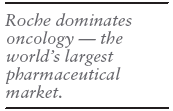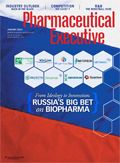The 7 Habits of Highly Effective Competitors
Lessons to win in a shifting market dynamic
In October 2013, Pharm Exec released its "12th Annual Pharmaceutical Industry Audit" (http://www.ittybittyurl.com/Wbi), which identifies how well companies advance shareholder value by evaluating eight benchmark corporate metrics. This audit ranked Novo Nordisk, Gilead Sciences, Biogen-Idec, Celgene, and Roche (in order) as the top five pharmaceutical companies. Editorial Advisory Board member Stan Bernard of Bernard Associates conducted an analysis of these five industry stalwarts to identify seven habits that drive their success. Here are his conclusions – William Looney, Editor in Chief.
Biopharma's best companies provide valuable lessons for preparing, planning, and playing to win. Here's how:
1 Commit To and Execute a Specialty Mission
In '61 President John F. Kennedy announced the aspirational goal of landing the first man on the moon and tasked NASA with this mission. While visiting NASA Space Center in 1962, he asked a janitor what he was doing. The janitor responded, "I'm helping put a man on the moon, Mr. President." While many biopharmaceutical companies focus on a specialty area, highly effective competitors ("HECs") focus on a specialty mission. Since 1923, Novo Nordisk's employees from top to bottom have fervently committed to "preventing, treating, and ultimately curing diabetes." Novo's CEO Lars Sørensen exemplifies the evangelical leadership and zeal that characterizes such companies and ensures employee alignment to and execution of this mission: "We attract people that want to work for a company that sees itself as part of a solution and are not just working for the money to reward the shareholders but to make a difference." Novo currently treats 20 million diabetics by manufacturing over 50% of the world's insulin, including generic insulin which is sold in emerging economies and extremely poor countries. Gilead Sciences, Biogen-Idec, and Roche are similarly passionate about overcoming viral diseases, multiple sclerosis, and cancer, respectively.

2 Knowingly Pursue and Develop the Best Products
HECs cleverly hunt for the best internal and external drug candidates and efficiently develop these compounds. They demonstrate exceptional scientific acumen, clinical judgment, and R&D leadership, the three top traits of successful R&D organizations, according to a recent BCG 10-year analysis of 842 developmental molecules. Moreover, HECs knowingly pursue compounds that their rivals might consider irrational gambles. For example, Gilead in 2011 took a seemingly huge risk by acquiring Pharmasset and its lead Hepatitis C ("HCV") antiviral compound sofosbuvir for $11 billion, the "largest deal ever for a company with no products in late stage development and valued at a 98% premium to its previous closing price," according to FirstWord Pharma. Sofosbuvir was considered a particularly risky compound since previous NS5B polymerase inhibitors for HCV had failed clinical development.
In fact, Gilead's senior leadership – including three top executives with science Ph.D.'s and over twenty years' experience at the company – made a shrewd scientific and strategic decision. The company relied on its leading anti-viral research experts and knowledge of nucleotides from its HIV research to place a huge bet that so far appears to have paid off. The FDA last month approved sofosbuvir under the brand name "Sovaldi," and FactSet Research Systems projects annual sales of the drug to reach $6.4 billion by 2017. Gilead exhibited the audit's highest "Enterprise Value Growth" measure for its unmatched operational efficiency.
Similarly, Celgene took a big strategic risk by developing a derivative of the notorious drug Thalidomide into the $4 billion blockbuster Revlimid for multiple myeloma. Not resting on its laurels, Celgene has emerged as "biotech's shrewdest, nimblest dealmaker" which is "fast building the biotech industry's best network of partnerships with innovators," comments Xconomy Biotech.
The company has acquired strategic players such as Pharmion and Abraxis Bioscience; partnered with many IPO companies such as Epizyme and Agios Pharmaceuticals; and invested in "some of the best venture-backed companies in the hottest areas of biomedicine," including epigenetics, immunotherapy, and regenerative medicine. According to Celgene's SVP Business Developmet George Golumbeski, "We tend to be looking for things that could be transformative, truly step-ahead therapies, not just incremental gains."
3 Win The Pre-Launch Phase
Once HECs find their products, they are experts at launching them. These top competitors conduct election-style — not military-style —launch campaigns and seek to win the "Pre-Launch Years" versus the traditional but belated "Launch Year." Novo's launch of GLP-1 diabetes agent Victoza demonstrated such extensive pre-market preparation. At an analysts meeting in 2010, Novo SVP Jakob Riis said, "We've also been very conscious about early on opting our resources and our preparedness to engage in ... 200,000 interactions last year of more than an hour's length with physicians globally explaining the science behind GLP-1" to maximize pre-launch awareness. Novo successfully counter-launched against Lilly's GLP-1 rivals Byetta and Bydureon, including stealing their thunder prior to the 2008 American Diabetes Association Meeting. The Journal of Managed Care Pharmacy highlighted Victoza's launch as a textbook case, saying the product "came to the market with unusually robust data demonstrating clinical comparative efficacy and safety," including head-to-head studies versus Byetta and other competitors. Despite being delayed by regulatory authorities, Victoza became a U.S. blockbuster within one year.

Biogen trumpeted its new MS therapy Tecfidera so much prior to its 2013 U.S. launch that analysts claimed there was "a bolus of patients in the queue ready to transition to therapy" with an estimated $100 million in pent up demand, which the Wall Street Journal reported "overwhelmed some pharmacies." Called the holy mother of all launches" by ISI analyst Mark Shoenebaum, Tecfidera doubled analysts' first quarter projections and is expected to reach blockbuster status in 2014 and exceed $5 billion annual global sales by 2018. FirstWord rates the launches of Tecfidera, Celgene's multiple myeloma agent Pomalyst, and Roche's breast cancer therapy Kadcyla as the top three 2013 product launches outperforming analysts' consensus projections.
4 Play Their Game
HECs shape their specialty markets to force rivals to play their game. For example, Gilead shaped the HIV market to be a drug combination game based predominantly on its compounds. A relatively late player in the HIV space, the company in 2004 launched the two-drug fixed-dose drug ("FDC") Truvada and two years later the three-drug FDC Atriplia, consisting of Truvada and Bristol-Myers Squibb's Sustiva (efavirenz). Preferring to use all Gilead ingredients, the company in 2012 launched a four-drug, once-daily single-tablet regimen nicknamed the "Quad" and branded as Stribild, which is projected to have 2015 sales exceeding $3 billion.
Gilead is determined to dominate the HCV space using the same game plan: leverage its new agent Sovaldi as the backbone for first-line HCV therapy and fixed-dosed combinations. As a testament to the company's competitiveness, Gilead has refused to collaborate with Bristol-Myers Squibb on co-development of a highly promising regimen featuring Sovaldi and BMS's drug daclatasvir; instead, Gilead has chosen to develop a similarly-effective HCV regimen featuring only Gilead products. Gilead's market-leading approach to drug combinations has transformed the HIV treatment paradigm and is likely to do the same in HCV.
5 Compete At Multiple Levels
HECs practice of "Multi-Level Competition," the strategy of seeking to win not only with individual brands but also at the franchise, portfolio, and corporate levels. Roche wants to win with its HER2 breast cancer agent Herceptin, a $5 billion brand; its emerging HER2 franchise which includes recently launched agents Perjeta and Kadcyla; its overall oncology portfolio which includes blockbusters Avastin and Rituxan as well as biomarkers and diagnostics; and to further enhance its industry-leading oncology reputation.
Similarly, Novo's diabetes portfolio offers multiple brands and franchises including basal, rapid-acting, and premix insulins; GLP-1 agents including Victoza and soon other GLP-1 combinations; and a myriad of devices. For over two decades, Biogen has concentrated on Multiple Sclerosis, resulting in the industry's most robust MS franchise (Tysabri, Avonex, Fampyra, and Tecfidera) to help manage this debilitating disease across its continuum. Competing at multiple levels provides many advantages, including better stakeholder relationships, more product combination opportunities, and improved operating efficiencies. Not surprisingly, Novo and Roche held the top two spots in the PE Industry Audit of sales-to-assets, a measure of corporate efficiency.
6 Mitigate the Impact of Payers and Generics
In the industry's Competitive Lifecycle Stage, both payers and generics represent significant threats. HECs realize that payers are not only customers but also potential "budget competitors," often fighting for the same funds as biopharmaceutical companies. These payers use numerous tactics to control the access, pricing, reimbursement, utilization, and perception of innovative drugs, including leveraging generic competition. Roche has relied on innovation to address payers and generics. The company recently launched 2nd generation follow-on products Gazyva and Kadcyla for its aging blockbusters Rituxan and Herceptin, respectively. Kadcyla, which links Herceptin's antibody with ImmunoGen chemotherapy agent DM1, is one of 25 antibody-drug conjugates in the company's pipeline.
Celgene has also emphasized new product development with a three-pronged strategy: expand Revlimid, its core $5 billion hematology-oncology agent, into new indications; develop new blockbusters such as apremilast for psoriasis and other indications; and build its early-stage pipeline through active deal-making. These efforts have provided Celgene with a 90% pricing margin, the highest in the PE Industry Audit.
7 Seek to Dominate Their Market
While many companies focus on specialty areas of unmet and growing therapeutic need, the most successful competitors seek to dominate and own their respective therapeutic areas. With an impressive portfolio of insulin and non-insulin products, Novo is the leading player in the burgeoning global diabetes market with a 27% global market share according to EvaluatePharma Research. Roche dominates oncology — the world's largest pharma market — where it owns nearly one-third of all cancer product sales worldwide totaling $22 billion. Roche markets the industry's three best-selling cancer brands and is poised to have five of the six best cancer sellers by 2018. Gilead is expected to capture 43% of all anti-viral sales by 2018 by owning the HIV area while challenging the HCV arena. Catapulted by its recently launched Tecfidera, Biogen will cast an increasingly dominant shadow over the MS market. The company is expected to grow from a 34% to a 50% share of the projected $20 billion MS market by 2018.
In summary, highly effective competitors demonstrate three fundamental ways to win. They prepare to win by committing to a specialty market mission with the right people and products. They plan to win by shaping their market and competing at multiple levels. They play to win by mastering the Pre-Launch, countering payers and generics, and seeking to dominate their competitors.

Stan Bernard, MD, MBA is President of Bernard Associates, LLC, a global pharmaceutical industry competition consulting firm. He can be reached at SBernardMD@BernardAssociatesLLC.com.
